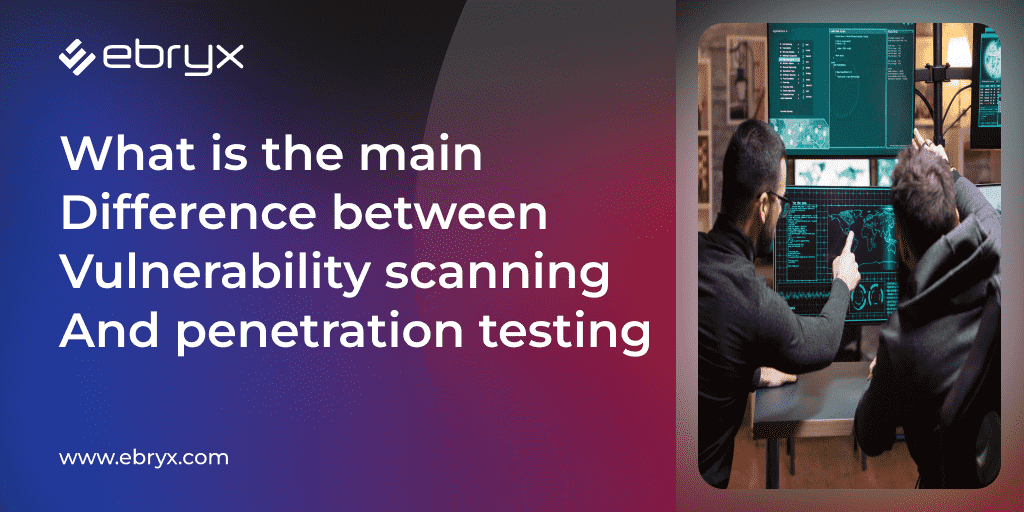

In the dynamic domain of cybersecurity, businesses endeavor to strengthen their digital assets to tackle extensive amount of threats. Two crucial pillars in this endeavor are vulnerability scanning and penetration testing. While these terms are often used interchangeably, they represent distinct processes, each serving a unique purpose in the quest for robust cybersecurity. In this comprehensive exploration, we'll delve into the main differences between vulnerability scanning and penetration testing, unraveling the intricacies that set them apart.
Vulnerability scanning is akin to a diligent detective searching for potential weak points in a digital world. It involves automated tools systematically scanning networks, systems, and applications to identify vulnerabilities. These vulnerabilities can range from outdated software versions and misconfigurations to known security loopholes.
One of the primary characteristics of vulnerability scanning is its reliance on automation. Automated tools swiftly and comprehensively analyze an organization's digital infrastructure, providing a snapshot of potential vulnerabilities. This efficiency makes vulnerability scanning an integral part of routine security measures, allowing organizations to identify and address issues promptly.
Vulnerability scanning offers real-time visibility into an organization's security posture. It enables the identification of weaknesses before they can be exploited by malicious actors. This proactive approach empowers organizations to stay ahead in the cybersecurity game, preventing potential breaches and data compromises.
While vulnerability scanning casts a wide net to identify potential weak points, penetration testing takes cybersecurity to the next level, adopting the perspective of a skilled adversary attempting to breach defenses.
Penetration testing involves ethical hacking techniques, where cybersecurity professionals simulate real-world attacks to assess the resilience of a system. This process goes beyond mere identification of vulnerabilities, actively exploiting them to understand the extent of potential damage.
Unlike vulnerability scanning's reliance on automated tools, penetration testing incorporates a significant human element. Skilled ethical hackers employ their expertise to mimic the tactics of cybercriminals, providing insights into the effectiveness of an organization's defense mechanisms against real-world threats.
While vulnerability scanning offers a snapshot of potential weaknesses, penetration testing provides a comprehensive understanding of the entire security landscape. This depth of insight is invaluable for organizations looking not only to patch vulnerabilities but also to refine their overall cybersecurity strategy.
Now that we have a foundational understanding of both vulnerability scanning and penetration testing, let's embark on a detailed comparative analysis to discern the nuances that set them apart.
Vulnerability scanning is typically a routine and automated process that organizations perform regularly. The frequency can range from daily to weekly, depending on the organization's size, industry, and regulatory requirements.
Penetration testing is conducted less frequently compared to vulnerability scanning. It is a more intensive process, often performed annually or semi-annually, due to its resource-intensive nature.
The approach of vulnerability scanning is passive and non-intrusive. Automated tools scan the system, identifying vulnerabilities without actively exploiting them. This makes vulnerability scanning a safer option for regular check-ups on an organization's security posture.
Penetration testing, on the other hand, is an active and intrusive process. Ethical hackers simulate actual cyberattacks, exploiting vulnerabilities to gauge the system's response. This aggressive approach provides a realistic assessment of an organization's readiness to face genuine threats.
The scope of vulnerability scanning is broad but not as deep. It provides a surface-level overview of potential vulnerabilities, making it suitable for routine checks and continuous monitoring.
Penetration testing has a narrower scope but delves deeper into identified vulnerabilities. It aims to understand the potential impact of a successful cyberattack and provides a detailed roadmap for remediation.
Many industry regulations and standards mandate regular vulnerability assessments. Vulnerability scanning, with its non-intrusive nature, aligns well with compliance requirements.
Penetration testing, being a more resource-intensive process involving skilled professionals, tends to be costlier. However, the insights gained from a thorough penetration test can be invaluable in preventing costly breaches.
Many industry regulations and standards mandate regular vulnerability assessments. Vulnerability scanning, with its non-intrusive nature, aligns well with compliance requirements.
Certain regulations, especially in industries dealing with sensitive data, may require organizations to conduct penetration testing. The depth of analysis provided by penetration testing often meets the stringent requirements of regulatory bodies.
In the dynamic domain of cybersecurity, understanding the nuanced differences between vulnerability scanning and penetration testing is paramount. While vulnerability scanning acts as an automated vigilante, patrolling the digital landscape for potential vulnerabilities, penetration testing takes on the role of an ethical hacker, going beyond identification to actively exploit and assess the resilience of an organization's defenses. In the pursuit of a comprehensive cybersecurity strategy, organizations often find value in integrating both vulnerability scanning and penetration testing into their security protocols. The synergy between routine checks and in-depth assessments contributes to a robust defense against the ever-evolving threats in the digital landscape. As we navigate the intricate maze of cybersecurity measures, it becomes clear that vulnerability scanning and penetration testing are not mutually exclusive but rather complementary. Together, they form a formidable duo, empowering organizations to fortify their digital fortresses against the relentless tide of cyber threats.
Embark on a cyber-defense journey with Ebryx, where our Penetration Testing services redefine the very essence of security assurance. Picture this – our expert ethical hackers, armed with a repertoire of cutting-edge tools and strategies, infiltrating your systems to expose vulnerabilities before the bad actors can even blink. Ebryx transforms the daunting prospect of cybersecurity into a proactive and empowering experience. Through meticulous assessments, we simulate real-world threats, providing you not just with a shield but with a fortified fortress against potential breaches. Our Penetration Testing isn't just about identifying weak points; it's a dynamic process that elevates your security posture to new heights. Join forces with Ebryx – where cybersecurity isn't a challenge; it's an opportunity to thrive securely in the digital era.


